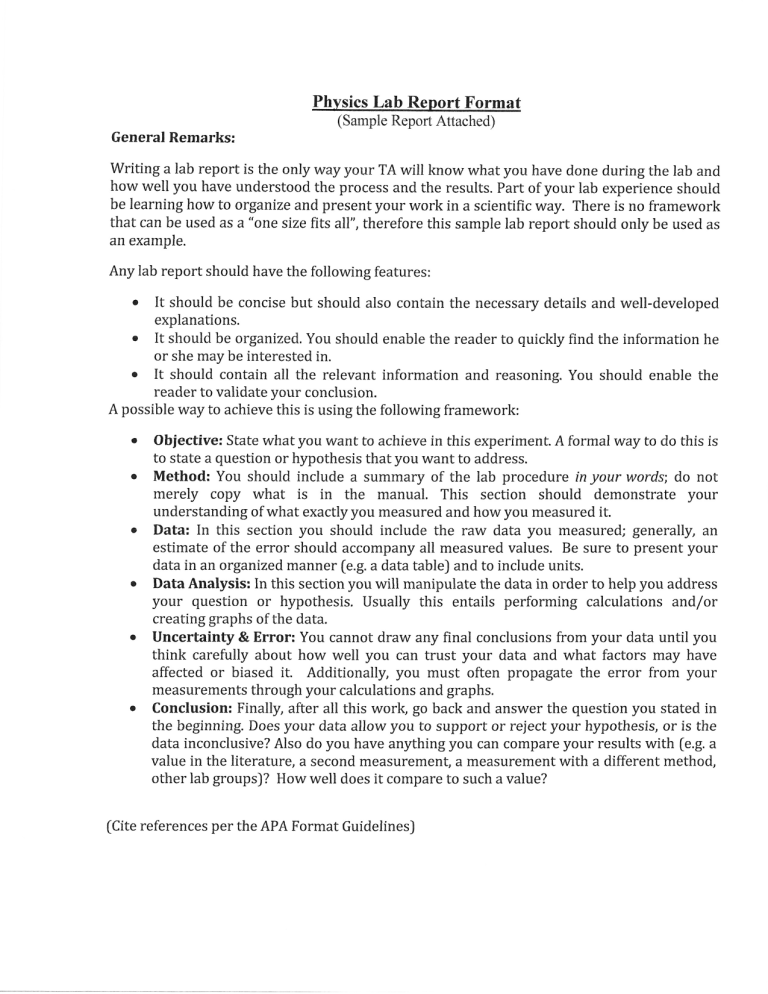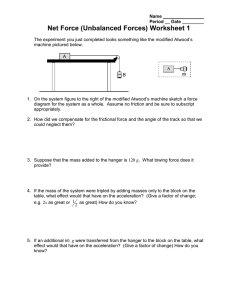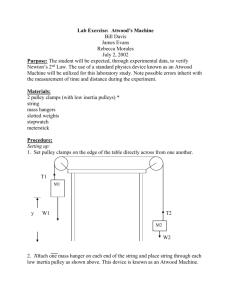Physics Lab Report Guideline and Sample Report
advertisement

Phvsics Lab Report Format (Sample Report Attached) General Remarks: Writing a lab report is the only way your TA will know what you have done during the lab and how well you have understood the process and the results. Part of your lab experience should be learning how to organize and present your work in a scientific way. There is no framework that can be used as a "one size fits all", therefore this sample lab report should only be used as an example. Any lab report should have the following features: o It should be concise but should also contain the necessary details and well-developed explanations. It should be organized. You should enable the reader to quickly find the information he or she may be interested in. It should contain all the relevant information and reasoning. You should enable the reader to validate your conclusion. A possible way to achieve this is using the following framework: o o . o o o o . Obiective: State what you want to achieve in this experiment A formal way to do this is to state a question or hypothesis that you want to address. Method: You should include a summary of the lab procedure in your words; do not merely copy what is in the manual. This section should demonstrate your understanding of what exactly you measured and how you measured it. Data: In this section you should include the raw data you measured; generally, an estimate of the error should accompany all measured values. Be sure to present your data in an organized manner (e.g.a data table) and to include units. Data Analysis: In this section you will manipulate the data in order to help you address your question or hypothesis. Usually this entails performing calculations andfor creating graphs ofthe data. Uncertainty & Error: You cannot draw any final conclusions from your data until you think carefully about how well you can trust your data and what factors may have affected or biased it. Additionally, you must often propagate the error from your measurements through your calculations and graphs. Conclusion: Finally, after all this worh go back and answer the question you stated in the beginning. Does your data allow you to support or reject your hypothesis, or is the data inconclusive? Also do you have anything you can compare your results with [e.9. a value in the literature, a second measurement, a measurement with a different method, other lab groups)? How well does it compare to such a value? (Cite references per the APA Format Guidelinesl Lab 3: Atwood Machine mm/dd/20L1. Newton's Second Law: the Atwood Machine Lab Report 3 General Physics I (or, Parker University Dr. Tison Month xx,20l1 II) Introduction: The purpose of this lab is to test Newton's 2nd Law of Motion by utilizing an Atwood machine apparatus. The Atwood machine will be used to study the relationship between mass, acceleration and net forces, with the distribution of the mass between the two weights being the independent variable and the time the dependent variable within the experiments. Hypothesis: It is hypothesized that the acceleration of the object observed will be directly proportional to the net force acting on the object and inversely proportional to the total mass of the object. Theory: In an Atwood's machine apparatus two sets of unequal masses are suspended from string on either side of a pulley. The larger mass, mz, provides a net force, Fnet a = (mz-mr)g thereby causing both masses to accelerate according to Newton's 2nd Law of Motion, Fnet = [mr+m2)a. Combining these 2 equations, the acceleration can be calculated by the equation, 2. = [[mz-mr)/ (mr+mzJ]g. It is also possible to determine the acceleration of the 2 masses by measuring the time it takes for the masses to descend a distance y to the floor, using the equation, ?6= 2y /t2 Acceleration will be determined from the time measurement data and will be compared with the value calculated from the known masses. Differences between these two values of acceleration will be expressed as aYo uncertainty. Error analysis to account for the 0/o uncertainty will include the Atwood's machine apparatus, the time measurement process, and the variability in the obseryer's data taking. Lab 3: Atwood Machine mm/dd/201L Experiment: Apparatus: Atwood's machine consisting of one pulley with string attached over pulley to two weight hangers; sets of gram-weights, meter stick and stopwatch. Procedure: Two experimental procedures will be conducted here. (A) Increasing total mass: Same amount of mass is added to each weight hanger. Experiment will be repeated five times, recording times of fall for each set of masses. (B) Increasing mass difference (keep total mass the same): Move masses from one side to the other and repeat measwement five times, recording times of fall for each set of masses. Data/Results: y = B0cm =0.BOm Equations: a. - [[mz-mrJ/ (mr+m2)]g a^= 2y/t2 o/o ertor = (lac-aml/a.J x 100 1. Increasing mass sum m1 m2 7Op 90 s, 110 e 130 s 150 s 90s 110 s 130 e L50 s I70 s Ac L.22m/s2 0.98m/s2 0.81m/sz 0.70m/sz 0.61m/s2 t L.15 s L.29 s 1.39 s 1.55 s 1.80 s dm L.ZLw/sz 0.96m/sz 0.83m/s2 0.67m/s2 0.49m/s2 o/o €rfor 0.820/o 2.04o/o 2.47o/o 4.29o/o L9.7o/o 2. Increasing mass difference m1 mz 150 s 130 e L70 s. L90 e 210 s 230 p 250 s 1I0 s 90s 70p €lc 0.6Tm/s2 L.B4m/s2 3.06m/s2 4.29m/s2 5.51m/s2 T 1.50 s 0.92 s 0.72 s 0.63 s 0.53 s €Im 0.7Lmls2 L.89m/s2 3.08m/s2 4.03m/s2 5.70m/sz %o error 16.4o/o 2.77o/o 0.650/o 6.060/o 3.44o/o 4 Lab 3: Atwood Machine mm/dd/20L1, Data Analysis: In the first experiment set, it became apparent that as the mass was increased on both sides with the same mass difference, it took the heavier side longer to touch the ground, and the acceleration is increasing. This is as expected. From the equatioll, dq = [(mz-mrJ/ (mr+mz)]g, the denominator is increasing and the numerator is constant therefore acceleration is increasing. If acceleration is increasing the measured fall time must decrease from the equation, a^= 2y/t2. In the second experiment, we found that an increasing difference between the weights shortened the time considerably. As discussed above this is as expected from the equations, a. - [(mz-mt)/ (mr+mzJ]g and a-=2y/t2 In both experiments the highest %o %o error calculations range from about Lo/o to 20010, with the errors for the smallest values of acceleration. The absolute difference between each set of values a. and am is fairly consistent. Experimental apBaratus errors: Force of friction in the pulley is a primary fsystematicJ source of error, which is difficult to quantiflr. Stretching of the connecting string is accounted by recording the height for each set of masses. Measurement errors: positional measurements with meter stick, and time measurement with stop watch. Observer errors: Height measurement variable fmeter stick not exactly vertical, estimated "last digit" of height measuremen! time measurement (reaction times to start/stop stopwatch) Lab 3: Atwood Machine mm/dd/20L1, Conclusion: By using Atwood's machine, Newton's law was successfully tested. With this experiment, the measurement of acceleration of the masses was determined from the mass loads, and a value for the acceleration of gravity was calculated from time measurements. The results are in close agreement with the hypothesis that the acceleration of the object observed being directly proportional to the net force acting on the object and inversely proportional to the total mass of the object. Though the data recorded was not completely accurate with the calculations conducted with Newton's 2nd Law of Motion, the approximate values were within one standard deviation. Frictional force in the Atwood's machine and observer's reaction time are the 2 main sources of error. One improvement is to raise the apparatus so that the distance of fall is larger and the measured fall time is increased. Reaction time errors (essentially constant) will be reduced as a percentage of the time measurements. Practical Applications: The Atwood machine has provided the design for many historical machines with the most obvious being the elevator. The elevator uses a counterbalance, which relieves the driving motor from the load of holding the elevator. This causes it to overcome the difference in weight and inertia of both of the masses. Additionally, this same principle is used in railways to connect cars on inclined tracks References: Dr. f. Tison, Physics Lab 3, Spring, 201.J,. Giancoli,Douglas C. @ 2005,Physics,Prentice Hall, 6ft edition. 6



